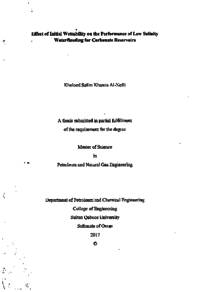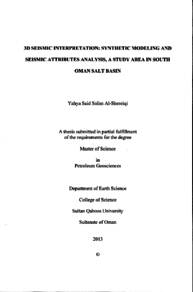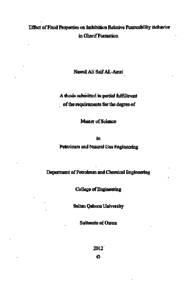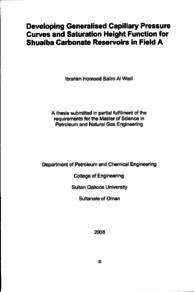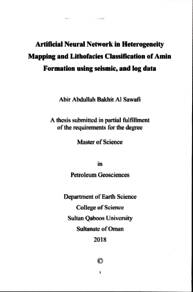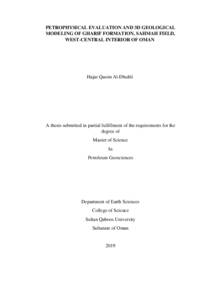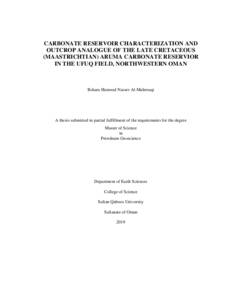Document
Effect of initial wettability on the performance of low salinity waterflooding for carbonate reservoirs
Publisher
Sultan Qaboos University
Gregorian
2017
Language
English
English abstract
In the following years, recovery of hydrocarbon fluids from the current oil fields must improve willing to keep up the worldwide developing demand of fossil powers. Carbonate reservoirs represent more than half of the world hydrocarbon reserves. The application of conventional water flooding methods for these reservoirs results in low oil recovery as a consequence of their oil-wet nature. Recently, exceptional considerations have been coordinated on modifying the chemistry of the injected brine which is represented by "smart water flooding" as an enhanced oil recovery technique (EOR). It is broadly trusted that ultimate oil recovery of a reservoir under smart water flooding is controlled by wettability alteration of the rock surface to a more water-wet condition. However, the main mechanism of low salinity flooding (LSF) in carbonate is not well understood and it is still debatable.
The purpose of this study is to investigate the effect of initial wettability of carbonate reservoirs on the performance of low salinity water flooding. Different analytical tools such as contact angle measurements, pH measurements, and EDS were used to provide inclusive analyses about wettability alteration of rock surfaces. Five initial wettability ranges were provided by aging calcite surfaces in brines or crude oil to mimic oil wet, intermediate wet, and water wet conditions. Four different low saline and smart brines were prepared by adjusting salinity and ion concentration to study their effect on wettability alteration. Our experiments showed that the aging time in oil affects initial wettability of carbonate rocks. Low salinity brine and designed smart brines are not suitable to be used for EOR and wettability alteration for samples initially strong water wet. Also, High salinity brine had no ability to alter wettability of samples which are initially oil-wet, and cannot be considered as a good choice for EOR in carbonate reservoirs. Brine with high magnesium ion concentration was slower in wettability alteration process for oil-wet samples than the brine containing both high magnesium and sulfate ions concentration. This was related to the catalytic role of sulfate ion compared to magnesium ion. Finally the results proved that the initial wettability of the reservoir affects the type of waterflooding method planned to be applied.
Member of
Resource URL
Arabic abstract
في السنوات القادمة ، يجب أن يحسن انتاج سوائل الهيدروكربونات من حقول النفط الحالية استعدادا لمواكبة الطلب العالمي المتنامي على القوى الأحفورية. وكما هو معروف أن مكامن الكربونات تمثل أكثر من نصف احتياطي الهيدروكربون العالمي. ولزيادة الانتاج من هذه المكامن يتم ضخ المياه إليها ولكن يؤدي الضخ بالطرق التقليدية للمياه إلى انخفاض انتاج النفط نتيجة لطبيعتها المبللة بالنفط. لذلك في الآونة الأخيرة، تم التوصل إلى طرق استثنائية تعتمد على تعديل التركيب الكيميائي للماء المضخوخ الذي يسمى ب " الماء الذكي" لتعزيز تقنية استخراج النفط. ومن الوثوق به على نطاق واسع أن الزيادة في انتاج النفط من مكمن طبق عليه ضخ المياه الذكية تكون بسبب تعديل خاصية البلل لسطح الصخور إلى حالة أكثر مبللة بالماء. ومع ذلك، فإن الآلية الرئيسية لعملية ضخ مياه بملوحة منخفضة في مكامن الكربونات ليست مفهومة جيدا ولا يزال موضع نقاش وبحث مستمرین.
الغرض من هذه البحث هو دراسة تأثير البلل الأولي لمكامن الكربونات على أداء تقنية ضخ مياه بملوحة منخفضة. وتم استخدام أدوات تحليلية مختلفة مثل قياس زاوية الالتصاق، وقياس درجة الحموضة، و تقنية تشتيت الطاقة للأشعة السينية الطيفية (EDS) , لتوفير تحليلات شاملة حول الية تغيير خاصية البلل للاسطح الصخرية. لذلك استخدمت خمس نطاقات للبلل الأولي لأسطح الكالسيت المنقوعة في المحاليل الملحية أو النفط الخام لمحاكاة خاصية البلل الزيتي والبلل المتعادل والبلل المائي، وتم تحضير اربعة محاليل ملحية منخفضة وذكية مختلفة من خلال تعديل الملوحة وتركيز الأيونات الدراسة تأثيرها على تغير خاصية البلل لعينات الكالسيت. واظهرت تجاربنا أن وقت النقع في النفط يؤثر على تغيير خاصية البلل الأولية لصخور الكربونات. المحاليل منخفضة الملوحة والمحاليل الذكية ليست مناسبة ليتم استخدامها لتعزيز انتاج النفط وخاصية تغيير البلل للعينات التي تتمتع بخاصية البلل المائي الأولي القوي. كما أن المحاليل ذات الملوحة العالية لم تكن لديها القدرة على تغيير خاصية البلل العينات التي تكون في البداية مبلولة زيتيا، ولا يمكن اعتبارها خيارا لتعزيز انتاج النفط في خزانات الكربونات. كان المحلول الملحي الذي يحتوي على تركيز عالي من أيون المغنيسيوم أبطا في عملية تعديل خاصية للبلل العينات ذوات البلل الزيتي الأولي من المحلول الملحي الذي يحتوي على كل من ايونات المغنيسيوم والكبريتات. وكان هذا مرتبطا بالدور الحفاز الأيونات الكبريتات مقارنة بأيونات المغنيسيوم. اخيرا أثبتت النتائج أن خاصية البلل الأولي للمكمن تؤثر على نوع الماء المستخدم في عملية الضخ المخطط تطبيقها.
الغرض من هذه البحث هو دراسة تأثير البلل الأولي لمكامن الكربونات على أداء تقنية ضخ مياه بملوحة منخفضة. وتم استخدام أدوات تحليلية مختلفة مثل قياس زاوية الالتصاق، وقياس درجة الحموضة، و تقنية تشتيت الطاقة للأشعة السينية الطيفية (EDS) , لتوفير تحليلات شاملة حول الية تغيير خاصية البلل للاسطح الصخرية. لذلك استخدمت خمس نطاقات للبلل الأولي لأسطح الكالسيت المنقوعة في المحاليل الملحية أو النفط الخام لمحاكاة خاصية البلل الزيتي والبلل المتعادل والبلل المائي، وتم تحضير اربعة محاليل ملحية منخفضة وذكية مختلفة من خلال تعديل الملوحة وتركيز الأيونات الدراسة تأثيرها على تغير خاصية البلل لعينات الكالسيت. واظهرت تجاربنا أن وقت النقع في النفط يؤثر على تغيير خاصية البلل الأولية لصخور الكربونات. المحاليل منخفضة الملوحة والمحاليل الذكية ليست مناسبة ليتم استخدامها لتعزيز انتاج النفط وخاصية تغيير البلل للعينات التي تتمتع بخاصية البلل المائي الأولي القوي. كما أن المحاليل ذات الملوحة العالية لم تكن لديها القدرة على تغيير خاصية البلل العينات التي تكون في البداية مبلولة زيتيا، ولا يمكن اعتبارها خيارا لتعزيز انتاج النفط في خزانات الكربونات. كان المحلول الملحي الذي يحتوي على تركيز عالي من أيون المغنيسيوم أبطا في عملية تعديل خاصية للبلل العينات ذوات البلل الزيتي الأولي من المحلول الملحي الذي يحتوي على كل من ايونات المغنيسيوم والكبريتات. وكان هذا مرتبطا بالدور الحفاز الأيونات الكبريتات مقارنة بأيونات المغنيسيوم. اخيرا أثبتت النتائج أن خاصية البلل الأولي للمكمن تؤثر على نوع الماء المستخدم في عملية الضخ المخطط تطبيقها.
Category
Theses and Dissertations

